A day ago I would have found nothing quite so terrifying as a gigantic hairy spider scuttling past just milimetres from my bare leg, pausing for a moment to eye me up as potential lunch. Normally I’d have shrieked like a girl, climbed to higher ground and commanded hubbie to remove the critter with all haste.
But not today.
Today I was buffalo ploughing, and nothing was going to get in my way!
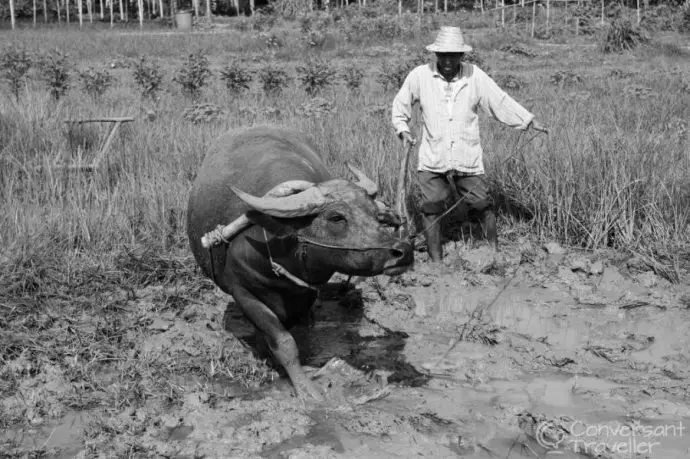
I’d been looking forward to our day at the Living Land Rice Farm for weeks, and was so excited that even the propsect of waterfall swimming, hill climbing and boating down the Mekong all paled in significance. The first thing I told anyone who foolishly expressed a polite interest in plans for our trip was that I’d be learning how to plough a rice paddy field with an actual buffalo. This revelation was met with equal measures of disbelief and envy, but people should know by know our travel spectrum lies at the opposite end to the sun loungers and beaches.
Living Land Rice Farm
The Living Land farm was set up by two brothers, Laut and Sia Lee, as a community project in a small village just outside Luang Prabang. The friendly staff are all local farming families and the rice produced on the farm feeds the whole village. Sticky rice is the staple food in Laos, with an adult consuming around 240kg of it a year. There are 4 different varieties of sticky rice grown here on the farm, including the more expensive (and my personal favourite) lavender-coloured rice used in desserts.
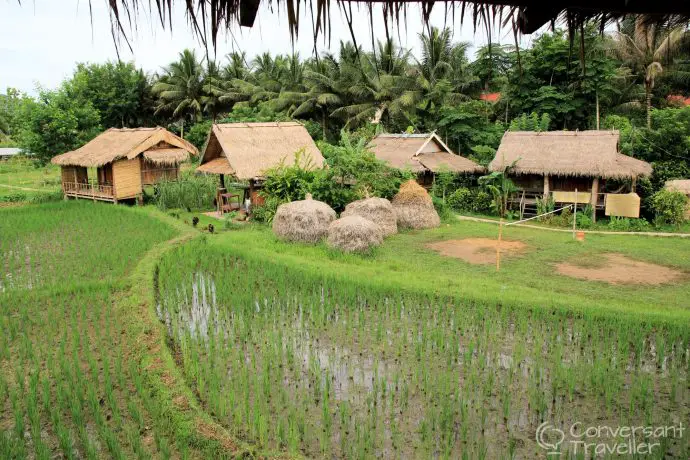
All production methods are organic and sustainable, with much of the salads, vegetables and herbs being used to supply restaurants and hotels in Luang Prabang. The garden plots at the edge of the paddy fields are filled with everything from pumpkins, okra and sugar cane to lavender, basil and rocket (some of which we tasted whilst walking round!), and at every corner there were compost heaps, wormeries, and bee hives.
Animals are distracted by swathes of bright orange marigolds, and insects repelled by strategically located citronella plants, leaving the precious food crops thriving safely in their beds. A most ingenious natural form of pest control. Those creatures undeterred by pretty flowers and scented plants usually end up in wooden traps, the most prevalent being snails, crabs and eels. Something different for the families to eat with the rice at dinner!
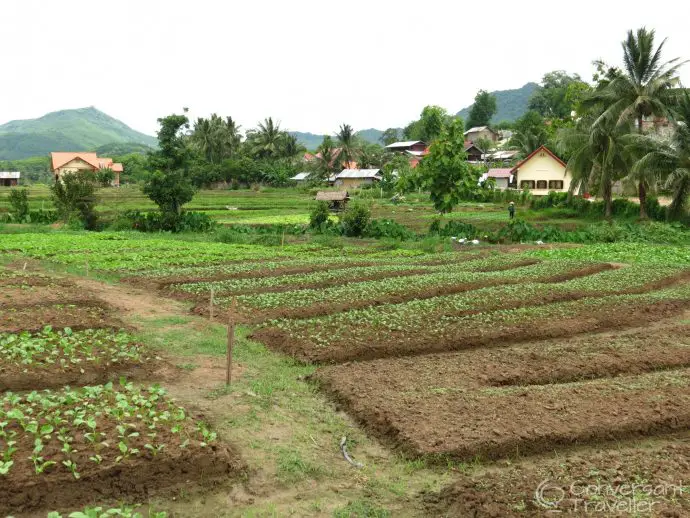
To share this knowledge and tradition, visitors are welcome to spend time at the farm, learning about the processes involved in rice production, and life on the farm. Profits from this venture are ploughed back into the farm, and used to put local children through school as well as offering on-site training and scholarships.
We’ve visited many rice paddies across Southeast Asia, and never really understood where the grains of rice actually came from. We didn’t know if they were in the roots, up the stems or in the water itself, so this seemed like a great opportunity to banish our ignorance and have fun doing it!
Becoming rice farmers for the day
We arrived at the farm in tuk tuk style and were greeted immediately by younger brother and Farm Manager Sia Lee who came bouncing down the path, full of energy and unbridled enthusiasm. There were just 4 of us visiting, so we felt less like tourists and more like family. The low season really is a fantastic time to visit! To my utter delight, before we could set off into the fields, Sia handed each of us the all important bit of Lao farmer kit.
You didn’t tell me I’d have to wear a hat!
I could feel hubbie’s accusing eyes boring holes into my back.
The picture of innocence, I turned around ready to lay on thick with the platitudes. Yet there really was no denying his head was too big for the conical bamboo hat to have any semblance of style, let alone dignity. I suppose I could have forewarned him, but that would have been a deal breaker and we might not be here today. Grumbling slightly he consented to wear the hat in the interests of harmony and respect, and followed me into the fields as I tried not to do a little jig at the thought of the fun morning ahead.
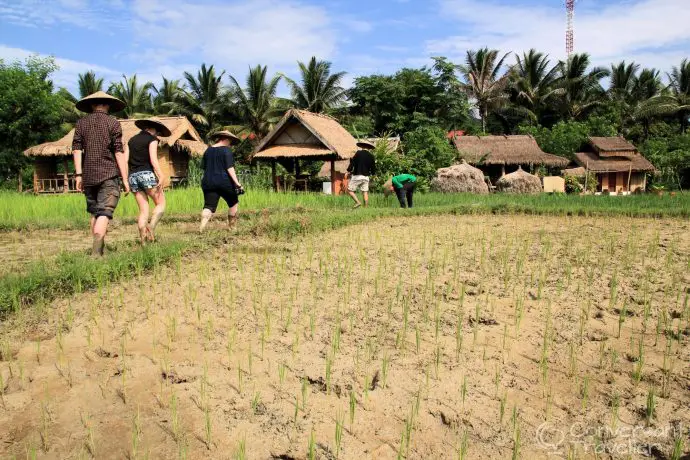
The 13 stages of rice production
Sia tells us there are 13 stages of rice production, or 14 if you count eating, which they do since 13 is an unlucky number there too! Who knew so much effort went into each single grain, the stuff we take for granted as we slip a boil-in-the-bag in a pan at home when we can’t be bothered to cook.
The approach is very hands on and we had a go at each of the different stages.
Ploughing
Afterwards hubbie tells he he was gobsmacked as I practically leapt into the mud and got stuck straight in (pun intended?). Normally I hate mud. But this wasn’t a normal day. Susuki the water buffalo lived up to her name as she left me behind on a couple of occasions. Apparently wading through knee high thick gloop whilst holding the plough in position and keeping up with a natural mud wallower isn’t the simplest of tasks for the uninitiated. Let alone one who isn’t known for her balance. Happily for all concerned I managed to stay upright and having seen photos of unfortunates who didn’t, I felt rather smug. Definitely the most fun bit of the day!
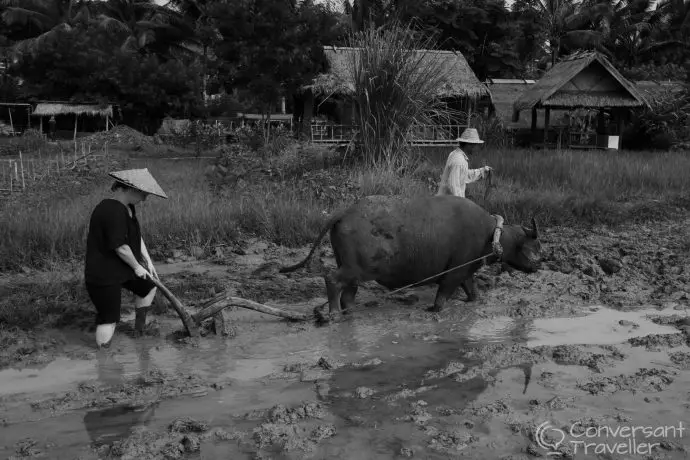
Watering and Planting
Once the field has been ploughed, it is irrigated and shored up to allow the water to accumulate. So, stepping into another paddy field, this time full of water as well as mud, we helped Sia plant the seedlings in lines (some straighter than others), thinking how cool it was that in about 3 months time someone would be eating that very rice. A couple of plants at a time are pushed gently into the mud, their leafy green heads poking out of the water and basking in the sun. In a few weeks the excess water will be drained out of that field to allow the roots to grow.
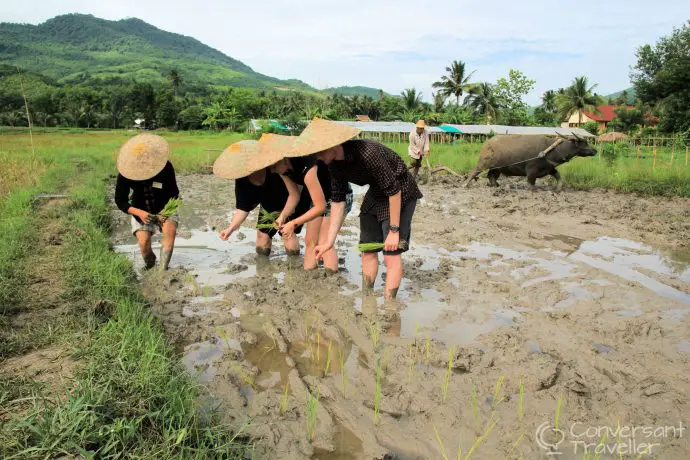
Harvesting and drying
Once the rice has grown to golden maturity it’s time for harvesting, with two or three plants being cut, bundled and tied together before being left to dry in the sun. For this we got to use a sickle made by the blacksmiths who work here in the pavilion, how cool! And we walked away with our legs in tact. Bonus! It was whilst I was hacking away with the blade that the enormous arachnid made his appearance, along with a couple of crabs which disappeared disconcertingly beneath the surface, inches from by submerged feet. I had an audience and the morals of Buddha to contend with so they all lived to crawl another day and I soon forgot about them as the task at hand took up all my concentration.
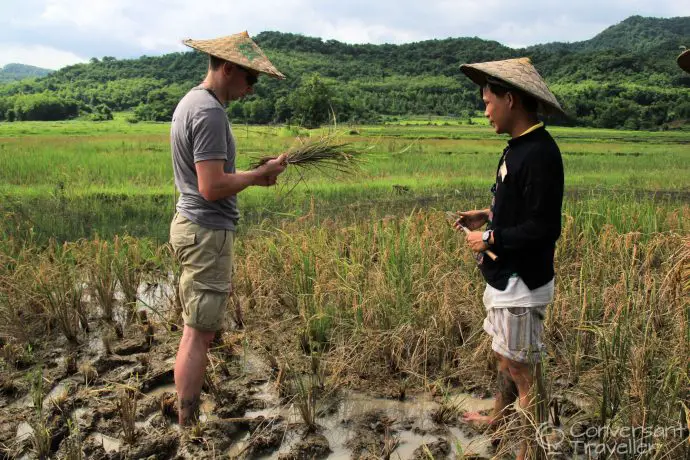
Threshing
This job required a bit of muscle, and I have to say hubbie (who had got into the swing of things and was now enjoying himself) excelled at releasing the grains from the stems by bashing the bundles against a wooden board. I was pretty useless at threshing, but hey, you can’t be good at everything.
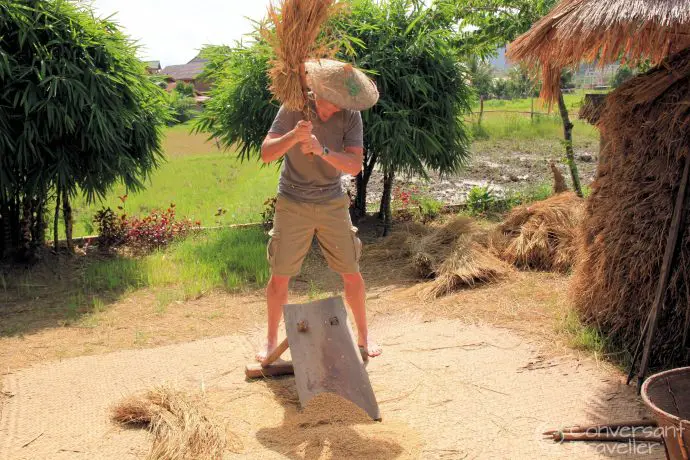
Wafting (I don’t think that’s the technical term!)
Still on a high from my buffalo ploughing, I didn’t allow my lack of prowess at this task bring me down. It’s one of those jobs that look easy but boy does it take some skill. We used a large bamboo paddle to waft over the pile, trying to separate the fully grown good rice from the lighter dried stems and unformed grains. Despite putting in a lot of effort, each time I brought my arm down with a swipe not even a single grain moved. I’m rapidly gaining a huge respect for rice farmers.
Basket transporting
Next we had to fill the basket with the separated rice which would then be carried by the workers from the fields to the mill area. Luckily Sia took pity on us and suggested we only fill it half way. Even so it was incredibly heavy, and a very strange and uncomfortable feeling carrying it using the traditional forehead strap.
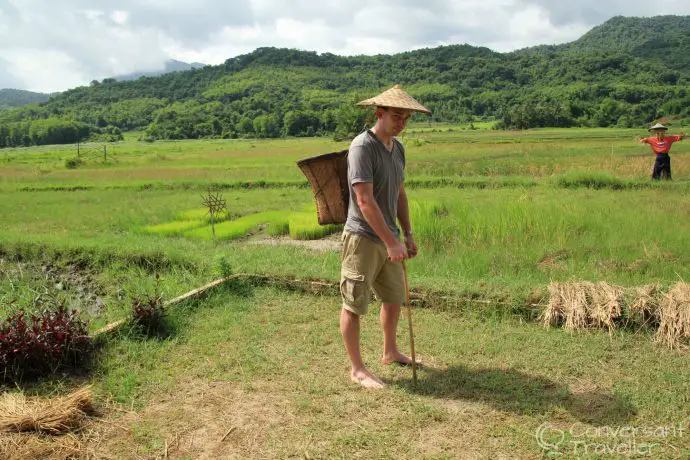
Crushing
Have you ever seen such a colossal pestle and mortar? This ancient husking mortar is over 100 years old and does a stirling job of crushing the grains. One of the most dangerous jobs has to be the that of the lady who between the descending blows of the giant wooden husker, uses her fingers to move the grain around so it is evenly crushed and nothing gets missed. She didn’t even blink an eye when we had a go, but I did notice she was concentrating intently as our inexpert feet pumped erratically at the other end.
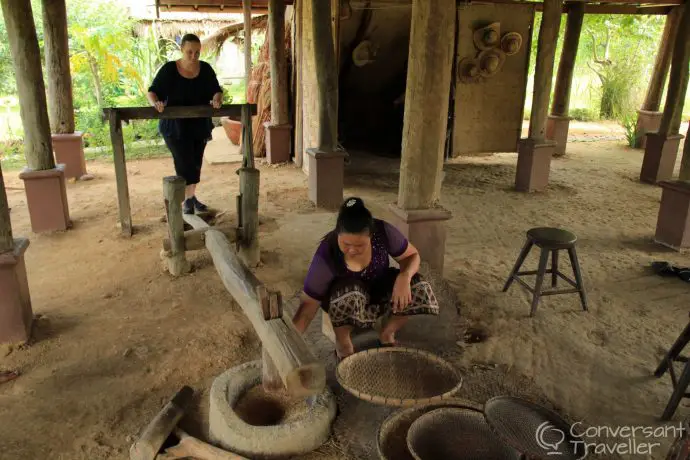
Winnowing
Apparently every Lao lady needs to master this skill if she wants to find a husband! It is fortunate, therefore, that I’m not Lao, and already have a husband who seems content with singed supermarket sausages and microwave rice. It’s a bit like gold panning (guess we’d have been useless during the gold rush too), using a large shallow basket to coax the lighter husks to the surface, leaving the unsplit rice grains ready for use.
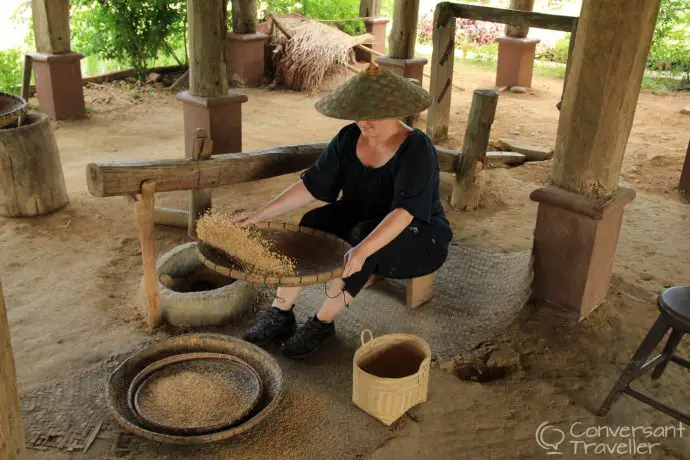
Testing the rice quality
The rice is then soaked in salted water where the good grains sink and the bad grains float. The latter are fed to the chickens so nothing is wasted. And finally…we have our rice!
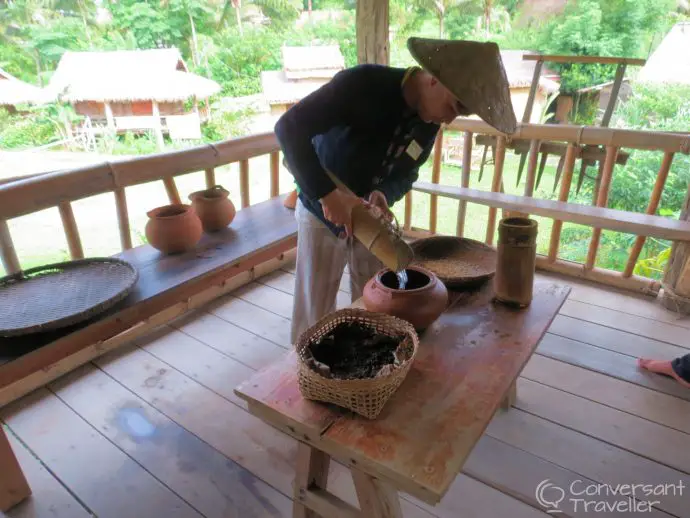
Grinding
Some of the grains are then gradually fed into a hole in the mill stone, which is being turned by an amazing contraption that functions purely on angles, persuasion and muscle. After a few false starts we all managed to get the thing going, and once you find your rhythm it’s quite a therapeutic sort of grind. The result some while later is very fine rice flour, used to produce all sorts of delicacies and confections you’d never even dreamed possible.
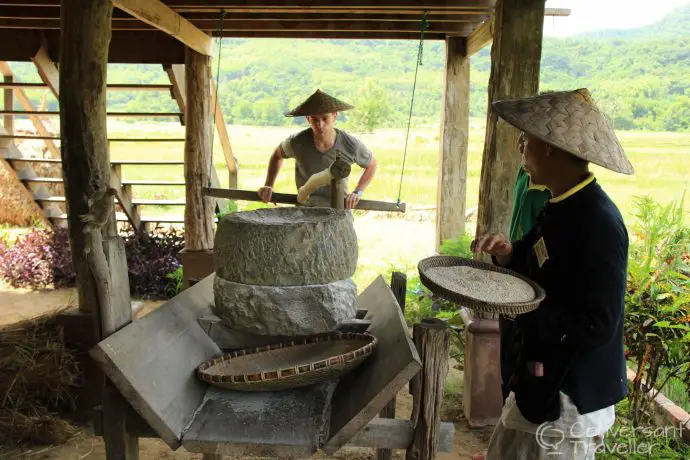
And this is how it’s done…
Cooking
Some of the rice escapes the mill stone and is steamed in special bamboo baskets over an open fire to produce the staple food that is sticky rice. Is has to be turned occasionally so the grains on top are cooked through, and is ready to eat in about half an hour.
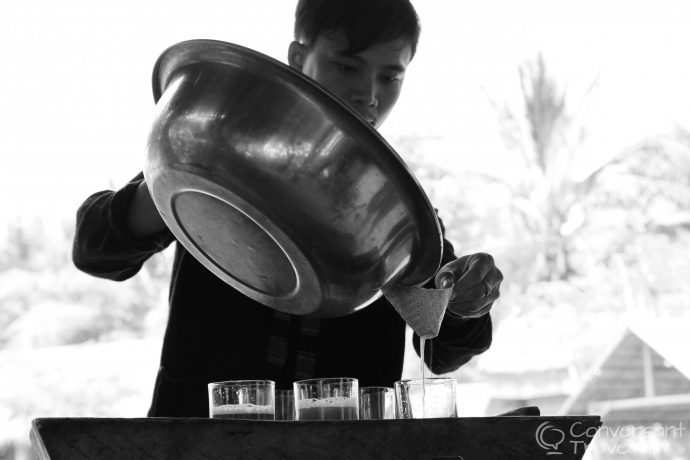
Whilst our rice lunch was cooking, we passed the time by crushing sugar cane and were glad of the sweet refreshing drink after running several exhausting circuits of the machine. It wasn’t as sickly sweet as I’d expected, and I found I quite liked the stuff.
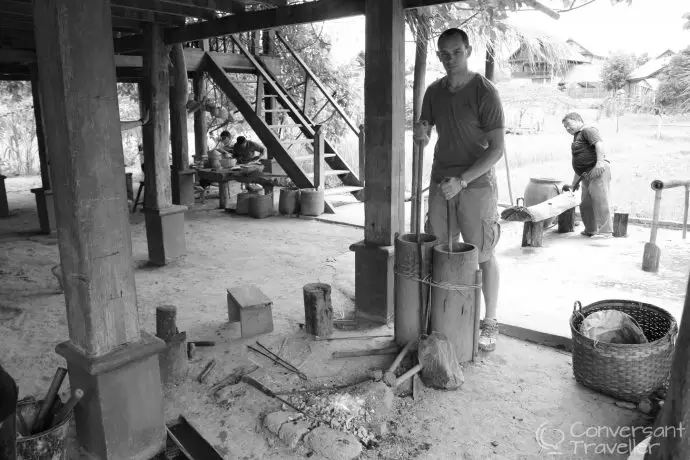
Sia also introduced us to the blacksmiths and farmers who were weaving baskets beneath the pavilion and we got to have a go at tool making, pumping the fire bellows and even making our very own bamboo buffalo. Some more successfully than others!
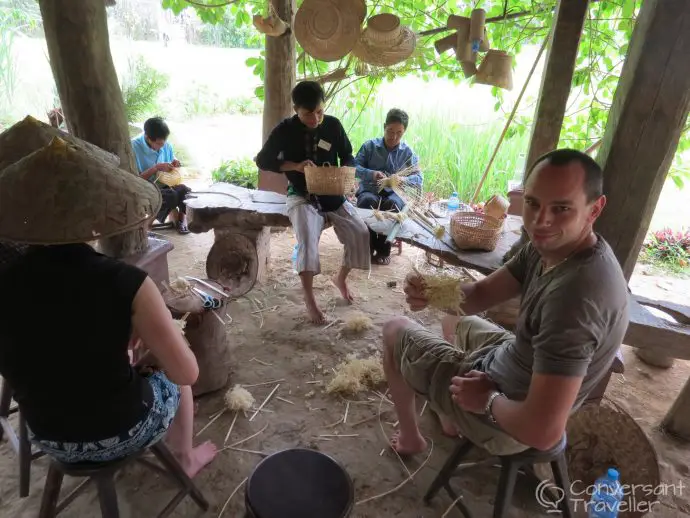
Eating
This was the stage we were best at!
Sitting on the upper deck of the wooden pavilion, enjoying a welcome breeze from across the paddy fields, we tucked into an aesthetic and tasty lunch of salted rice cakes, sweet crispy rice waffles, crispy rice coated in caramelised molasses, light sugar rice cones, and of course fresh sticky rice, served with the obligatory jeow, firey red chilli paste.
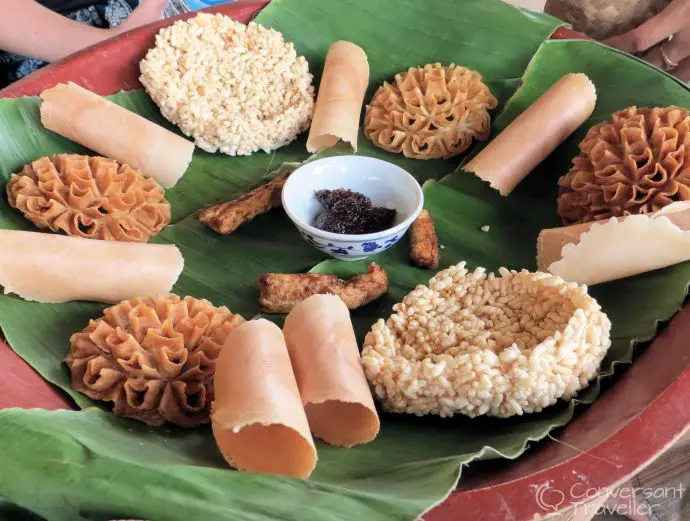
It was all delicious, and washed down by some rather excellent rice wine which had been fermenting away for 6 days.
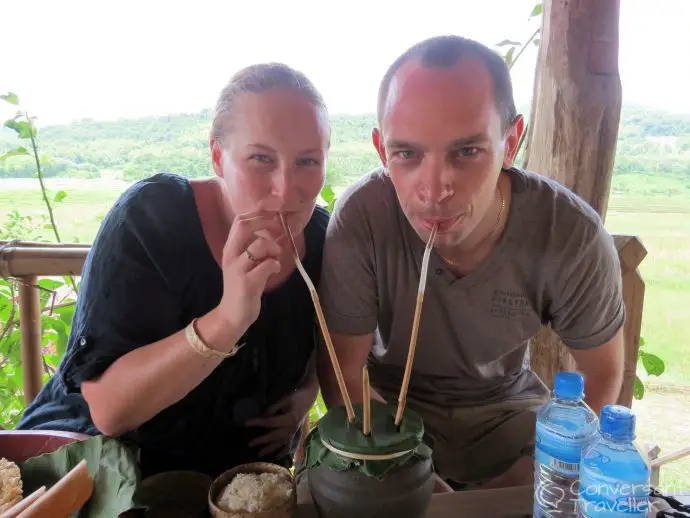
Rather potent, as we shared it around the table (each of us us thoughtfully provided with our own straws) it soon had us grilling Sia on his life and family. It quickly became apparent there is more to him than simple honest work and a great sense of humour. Originally from the distant mountains in the north, Sia’s family is Hmong and he is one of 13 siblings. His ancestors came from Vietnam and northern China, and Sia has travelled to Hong Kong and Siem Reap to learn some of the skills and knowledge that make him such a great guide and worker today. As well as speaking 3 languages (Lao, Hmong and English) he’s also done a degree in I.T. (he designed the Living Land website) and is currently doing a course in photography.
I hope he doesn’t mind me talking about him like this. I just found him to be such an inspiring person, a pleasure to learn from, and I think that what they are doing at Living Land is fantastic in both concept and execution. Sia is definitely one of the best guides we’ve ever had on our travels, and the day at the farm has to be my new favourite holiday experience!
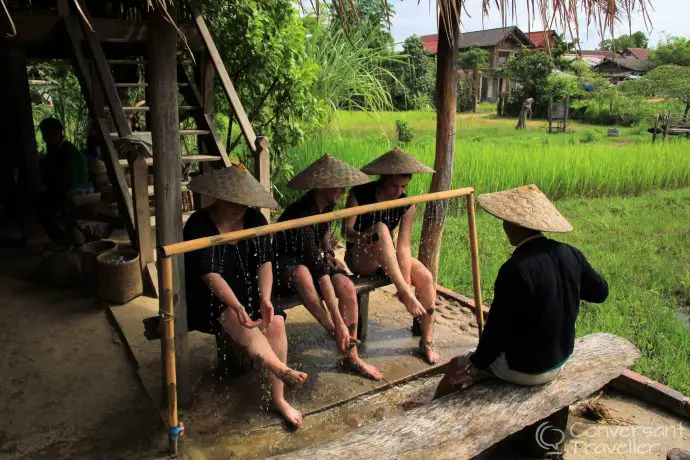
Good to Know
It cost Kip 344,000 per person (although we were given a discount since there were more than 2 of us!).
The programme runs in the morning only, with pick-ups from your hotel in Luang Prabang around 8am.
Wear shorts. You will be wading in mud. And possibly sitting in it depending on your balance.
There are biting flies but once you’re covered in mud these aren’t a problem!
The paddy fields are worked on a rotation system so that whatever time of year you visit you will be able to experience all the stages of rice production.
Note: Despite her off-road capabilities, Susuki the buffalo isn’t in fact named after a motorbike or a 4×4. She is the daughter of Susan the buffalo, and I suspect the name might relay that fact, the clue being in the spelling!
Enjoyed this post? Why not pin it for later…
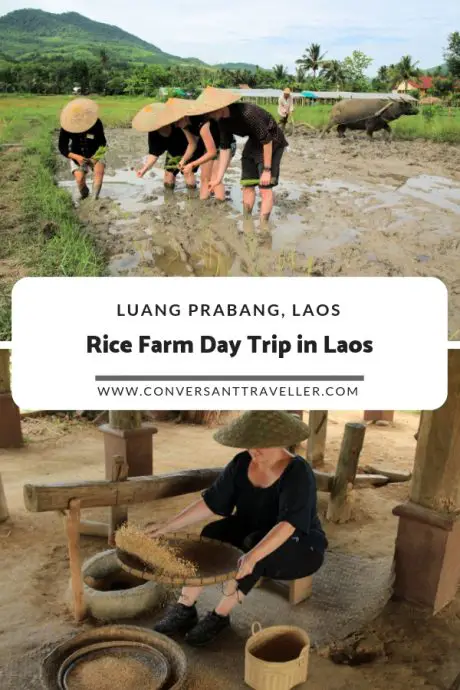

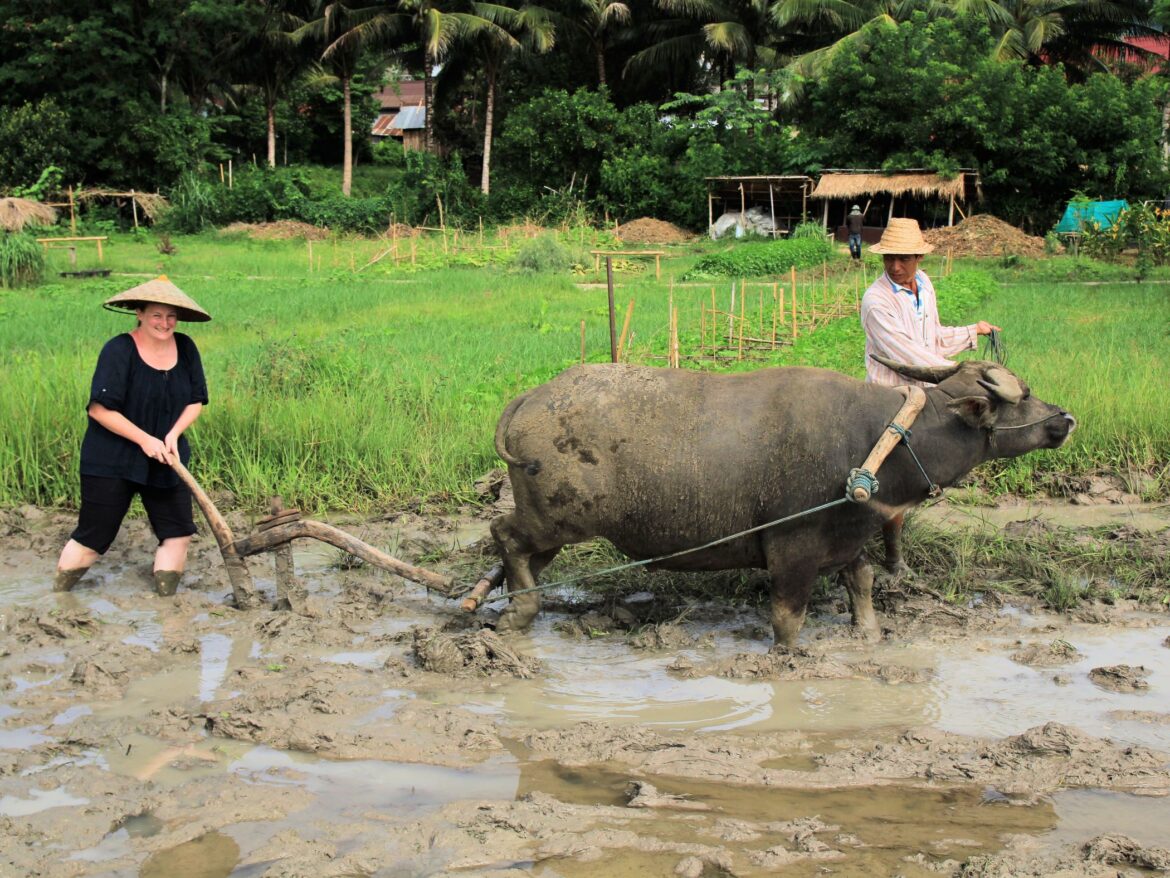
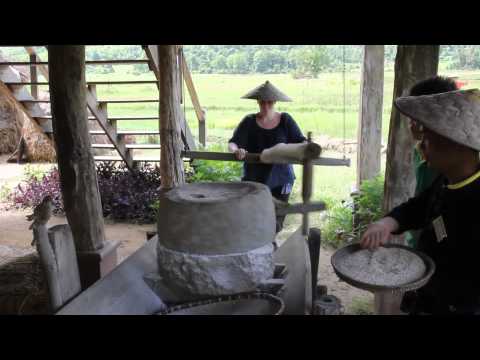
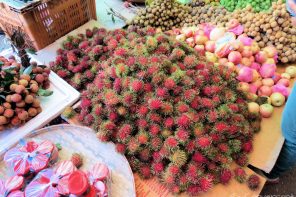
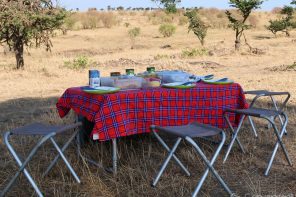
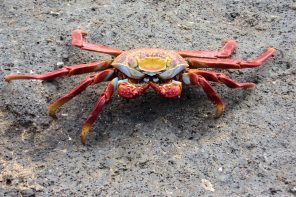

That mortar and pestle is certainly colossal! Well done for getting stuck right in there and being so enthusiastic about this local activity. I want to give a high five to Sia for doing so well for himself and the community <3
He really is an inspiration, just hope more and more travellers visit the farm to help spread the word!
That’s an amazing experience! So much better than just by the pool. 🙂
Yeah, the pool was for afterwards (after washing off all that mud!)
Wading into the pool of mud looks fun but also like hard work!
I knew rice growing was a tough job, but it seems even tougher after reading your thorough post, Heather. But I have to say it looks so much fun and delectable too (at least the desserts) :))
Cheers for a fantastic post,
Svet
I’ve never known how the whole process goes, so it was really interesting reading your post. The photos are also great and it looks like you had a great experience. I would love to do that one day too! 🙂
Wow! Making rice sure is complicated! I explored a rice plantation in Malaysia, but didn’t learn or partake in all of the steps for making it. I guess those citronella plants are found at rice fields all over because they were in Malaysia as well. I thought it was so smart to use something organic to keep the bugs away. Did this farm also use garlic and hot pepper as an organic insecticide?
I guess they’re similar all over the world, and it makes so much sense to use organics like this doesn’t it…not sure they used the garlic or pepper here but I can imagine they’d work really well!
What an interesting process. It seems rather primitive, but definitely organic! And more meaningful because it is such an important part of their culture.
Wow, what an amazing experience. What a great idea to do that and experience real life culture and experience.
What an amazing experience you had much better than sitting by a pool…I actually like the idea of the mud takes me back to my childhood lol
We did sit by a pool…of mud, ha ha! You must have had an interesting childhood 🙂
Wow, what an awesome experience! I would have never even considered buffalo ploughing, but it looks as if you had a great time (hats and all!). I’ve been meaning to get to that side of the world for a long time, and when I finally do this is something I will definitely look up. Great post!
Thanks Jessica, it really was one of the best things I’ve ever done whilst travelling, it’s great being hands on and experiencing things from the inside rather than always being an outsider looking in!